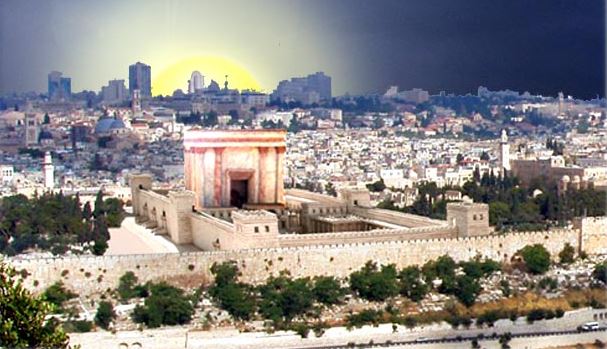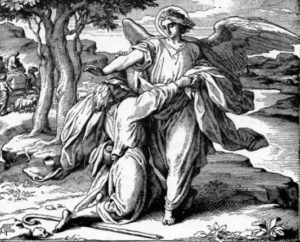In this week’s parasha, Vayikra, we see the word HaMashiach (המשיח) appear for the first time. In fact, the word only appears a total of four times in the entire Torah, three in this week’s parasha, and once next week. In all four cases, the Torah is not speaking of the messiah, but rather of the High Priest, the anointed kohen gadol. Of course, this is only true on the surface, peshat, level. On a deeper, mystical level the Torah is indeed alluding to the messiah at the End of Days.
It is fitting that we are reading these words now, when the Jewish world is abuzz over what coronavirus means in the grand scheme of things, and whether, perhaps, it is a sign of Mashiach’s coming. Jewish social media is full of posts and reposts affirming that coronavirus is absolutely a sign of Mashiach’s arrival, with all kinds of “proofs” based on gematria and ancient prophecies. While some of these are accurate, others are nonsensical, absurd, or just plain fake, so it is worth checking the sources behind everything you receive.
Many of the posts cite the same verse, Isaiah 26:20: “Go, my people, enter your chambers, and lock your doors behind you. Hide but a little moment, until the fury passes.” This verse is indeed a prophecy for the End of Days. The preceding verse speaks of the Resurrection of the Dead (“Your dead shall live, dead bodies shall arise; those that dwell in the dust will awake and sing…”) while the verse that follows describes God’s final retribution: “Behold, God shall come forth from His place to punish the dwellers of the earth for their iniquity…” Having said that, it isn’t only sinners that perish. On the contrary, Isaiah cautions everyone to hide behind closed doors for, as the Sages teach, in such moments the angel of death is let loose and doesn’t differentiate between the righteous and the wicked. (For a detailed explanation of this, see Alshech on Exodus 12:13.)
Now, what exactly is the nature of the za’am (זעם), “fury”, that Isaiah speaks of? Is it really a virulent plague?
A Plague Before Mashiach
In several places, the Sages speak of a great plague that will befall the world before Mashiach comes. Possibly the earliest mention of this is Tosefta Ta’anit 2:11, where the Sages discuss if a global flood can come upon the Earth again, since God promised it wouldn’t (Genesis 9:15). The Sages qualify that statement:
Rabbi Meir said: A flood of water will not come again, but a flood of fire and brimstone will, like He brought upon the people of Sodom, as it is written, “And God rained upon Sodom and Gomorrah brimstone and fire.” (Genesis 19:24) Rabbi Yehudah said: A flood upon the whole world will not come again, but a flood upon individuals will, such as if a person is at sea and his ship sinks and he dies—this is like a personal flood. Rabbi Yose said: A flood of water will not come again, but a “flood” of plague upon the idolaters in the days of Mashiach will…
A similar statement is found in the Midrash (Shir HaShirim Rabbah 2:13):
“The fig tree puts forth her green figs…” (Song of Songs 2:13) Said Rabbi Chiya bar Abba: before the days of the messiah, a great plague will come to the world, and the sinners will succumb to it “…and the vines in blossom give forth their fragrance…” (ibid.) These are the survivors, of whom it is said: “And it shall be, that he that is left in Zion, and he that remains in Jerusalem [shall be called holy…]” (Isaiah 4:3)
Such passages agree that a devastating plague will come upon the world at the End of Days to strike down idolaters and sinners (though even the righteous will suffer among them). It is interesting to point out how the coronavirus we are dealing with today has, strangely, left the vast majority of children unaffected, with mild symptoms, or none at all. Scientists have yet to find a good explanation for this baffling phenomenon. Perhaps, from a spiritual perspective, it is because innocent children cannot be categorized as “sinners” or “idolaters”, and are being spared.
The Midrash Rabbah quoted above goes on to cite a couple of passages that also appear in the Talmud about the final seven-year period before Mashiach comes, and the state of the world during that time. We’ve written about both of these prophecies on multiple occasions in the past (see, for example, #21 here), so we shall not repeat them. It suffices to say that much of what the Sages predicted has come true. The final sign given in the lengthy midrashic passage is that if you see a generation where people are growing bolder and bolder, love to “rant and rave”, where blasphemy is widespread and people constantly “taunt” God, you should expect Mashiach to be near.
This is one of the factors that distinguish between the current state of the world compared to previous global plagues. For example, the Spanish Flu that started in 1918 certainly qualifies as a great plague that engulfed the entire world, with an estimated 50 million deaths. It came at the same time as World War I, and there were certainly Jews then who expected Mashiach imminently. The critical difference between then and now is the set of prophecies in the Talmud, which are more descriptive of today’s world than, say, 1918, as well as the fact that today we have the State of Israel. The latter is especially significant, since Ezekiel (ch. 37-38) prophesied that Jews would first return to Israel, settle down and build a prosperous country, and only then Mashiach would come. Thus, it is only today that essentially all the prophecies have been fulfilled. And there is at least one more.
Rome and the Enemies of Israel
Another intriguing prophecy that has been brought to light in recent days is the destruction of Rome. The notion that Rome will be crushed before Mashiach comes is found across ancient Jewish texts. This is because, of course, for most of history the biggest oppressor of Israel has been Rome. It was Rome that destroyed the Temple in Jerusalem and thrust the Jewish people into this current, millennia-old exile. From historical records, we know that Rome enslaved countless Jews, far more than any other empire in history (see, for example, Samuel Kurinsky’s The Eighth Day). Later, Rome transformed into the Christian Empire—its seat being the Vatican in Rome—from which horrifying crusades, inquisitions, and other terrors were launched.
For the Sages, the greatest enemy was always Rome, and for Mashiach to come it meant Rome must fall for good. The Talmud (Sanhedrin 98a-b) records how when the students of Rabbi Yose ben Kisma asked him when Mashiach would come, he answered: “When [Rome] falls down, is rebuilt, falls again, and is again rebuilt, and then falls a third time, before it can be rebuilt the son of David will come.” Rabbi Yose predicted that Rome would fall three times. The third would be the last, and then Mashiach would come.*
While the city of Rome has been conquered and sacked multiple times, there have been three major powers that can be called “Rome”. The first was the Roman Empire itself, which formally came to an end in 476 CE. Then, in 800 CE, Pope Leo III resurrected the title and crowned Charlemagne as Roman Emperor once more. What followed was the era of the “Holy Roman Empire”. By 1648, the Holy Roman Empire was dismantled (though the title was carried on by some German powers until 1806). Finally, in 1861 the various kingdoms and states on the Italian peninsula unified to form the modern nation-state of Italy in the hopes of forging a renewed, strong Rome. Today’s Italy can therefore be seen as the third incarnation of ancient Rome. (This is all the more compelling when we remember that Italy was Hitler’s primary ally.)
As it stands currently, Italy has been hardest hit by the coronavirus. They have already had more than double the casualties of China, where the plague began. While we sincerely wish for everyone around the world to be healthy and protected from this dreadful pandemic, it is understandable why some have connected Italy’s unfortunate (and inexplicable) fate to this ancient prophecy. On that note, closely following Italy in terms of casualties are Spain and Iran—probably next in line when it comes to horrible treatment of the Jewish people throughout history. Of course, these numbers will change with time, and we pray for the plague to end immediately so that none more shall perish, no matter where they happen to live.
A Final Prophecy and a Call to Action
The Sages famously state that “in Nisan they were redeemed, and in Nisan they are destined to be redeemed again.” (Rosh Hashanah 11a-b) Just as the Israelites were saved from ancient Egypt in the month of Nisan, the Jewish people in the End of Days will be saved in the same month. The Sages actually debate in these pages whether the Redemption will take place in Nisan or in Tishrei, bringing various Scriptural proofs for both possibilities. The only conclusion is that both must happen: the process will begin in Nisan, and end in Tishrei, with the blowing of the Great Shofar.
Tonight, we usher in the month of Nisan. It is a most auspicious time to bring about the Final Redemption. Now is the time to take this opportunity seriously and prepare. Thankfully, God has made it easy—after all, just about everything is closed. There are no shows, no sports games, no vacations, no activities. There is nowhere to go. For most people, there is no need to even go to work. All distractions are out of the way. Now is the time for Torah and mitzvot, for prayer and repentance.
Finally, the Sages state that the best way to bring Mashiach is for all the Jewish people to keep Shabbat together, and that if the entire nation kept just one Shabbat properly, Mashiach would come (Shemot Rabbah 25:12). The Sefat Emet (Rabbi Yehudah Aryeh Leib Alter, 1847-1905) added that the ideal time for this unified Shabbat is the last Shabbat of the month of Adar, right before the start of Nisan (see his commentary on Parashat Zachor). That Shabbat was just a few days ago, and it just so happened that the parasha we read was Vayakhel-Pekudei, which begins with God’s command to keep the Sabbath! (Exodus 35:2) The timing couldn’t be better. Heck, even the Pope has called for everyone to keep Shabbat like the Jews!
With the State of Israel, and much of the rest of the world, currently on lockdown, God has made it especially easy for us to fulfil one proper, nation-wide Sabbath. This week we have another tremendous opportunity, and the Shabbat that follows is Shabbat HaGadol, the “Great Sabbath” before Pesach. If we do our utmost now then maybe, just maybe, it will be the Great Sabbath that brings the Final Redemption.
*Click here to read about the “Three Romes” and the coming of Mashiach from a different perspective.


